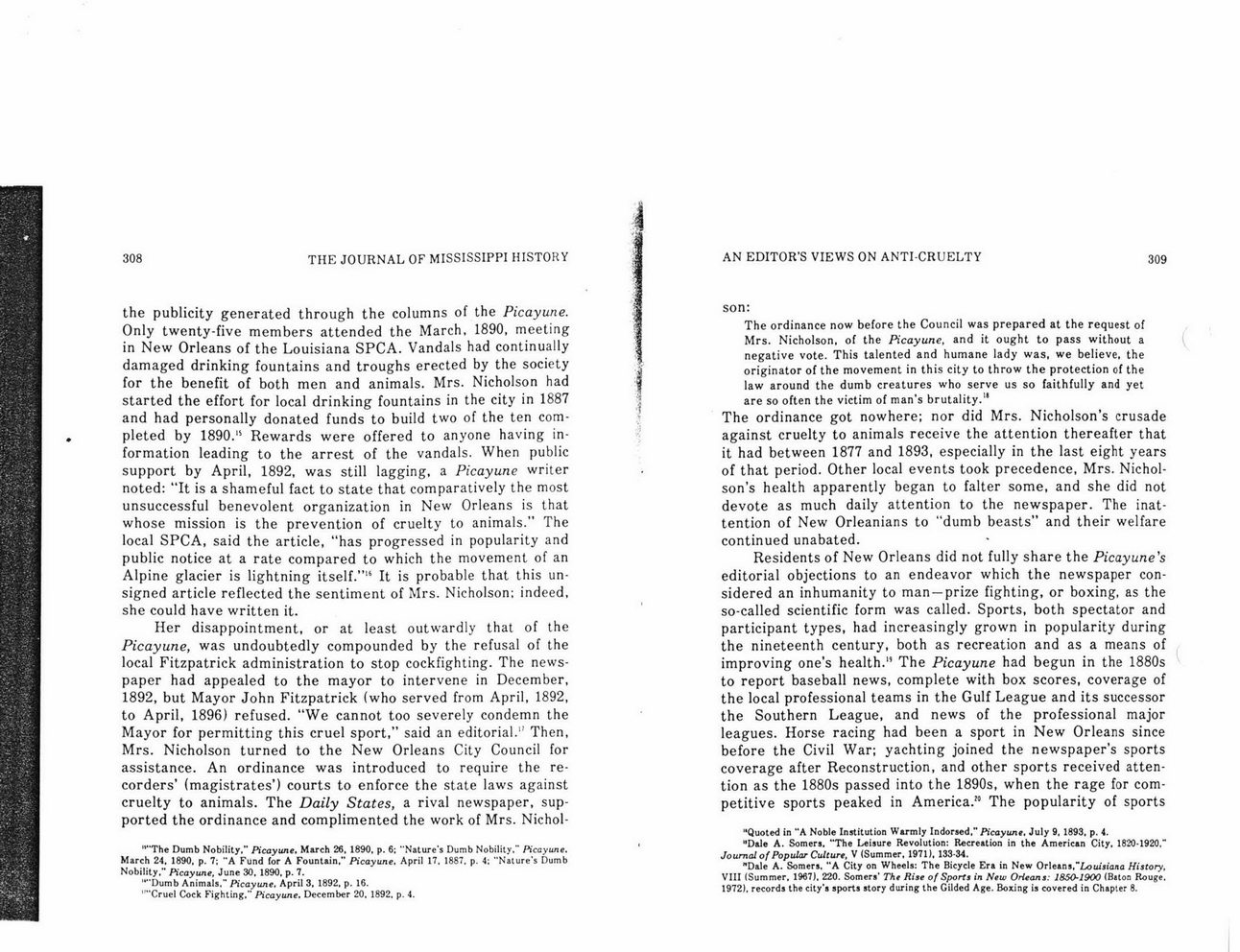This text was obtained via automated optical character recognition.
It has not been edited and may therefore contain several errors.
308 THE JOURNAL OF MISSISSIPPI HISTORY the publicity generated through the columns of the Picayune. Only twenty-five members attended the March, 1890, meeting in New Orleans of the Louisiana SPCA. Vandals had continually damaged drinking fountains and troughs erected by the society for the benefit of both men and animals. Mrs. Nicholson had started the effort for local drinking fountains in the city in 1887 and had personally donated funds to build two of the ten completed by 1890." Rewards were offered to anyone having information leading to the arrest of the vandals. When public support by April, 1892, was still lagging, a Picayune writer noted: ?It is a shameful fact to state that comparatively the most unsuccessful benevolent organization in New Orleans is that whose mission is the prevention of cruelty to animals." The local SPCA, said the article, ?has progressed in popularity and public notice at a rate compared to which the movement of an Alpine glacier is lightning itself.?11 It is probable that this unsigned article reflected the sentiment of Mrs. Nicholson; indeed, she could have written it. Her disappointment, or at least outwardly that of the Picayune, was undoubtedly compounded by the refusal of the local Fitzpatrick administration to stop cockfighting. The newspaper had appealed to the mayor to intervene in December, 1892, but Mayor John Fitzpatrick (who served from April, 1892, to April, 1896) refused. ?We cannot too severely condemn the Mayor for permitting this cruel sport,? said an editorial.1' Then, Mrs. Nicholson turned to the New Orleans City Council for assistance. An ordinance was introduced to require the recorders? (magistrates?) courts to enforce the state laws against cruelty to animals. The Daily States, a rival newspaper, supported the ordinance and complimented the work of Mrs. Nichol- ??The Dumb Nobility," Picayune, March 26, 1890, p. 6; "Nature's Dumb Nobility,? Picayune. March 24, 1890, p. 7; MA Fund for A Fountain,? Picayune. April 17, 1887. p. 4; "Nature?s Dumb Nobility,? Picayune, June 30, 1890, p. 7. ??Dumb Animals.?* Picayune. April 3. 1892, p. 16. "??Cruel Cock Fighting." Picayune, December 20, 1892, p. 4. AN EDITOR?S VIEWS ON ANTI CRUELTY 309 son: The ordinance now before the Council was prepared at the request of Mrs. Nicholson, of the Picayune, and it ought to pass without a negative vote. This talented and humane lady was, we believe, the originator of the movement in this city to throw the protection of the law around the dumb creatures who serve us so faithfully and yet are so often the victim of man's brutality." The ordinance got nowhere; nor did Mrs. Nicholson?s crusade against cruelty to animals receive the attention thereafter that it had between 1877 and 1893, especially in the last eight years of that period. Other local events took precedence, Mrs. Nicholson?s health apparently began to falter some, and she did not devote as much daily attention to the newspaper. The inattention of New Orleanians to ?dumb beasts? and their welfare continued unabated. Residents of New Orleans did not fully share the Picayune's editorial objections to an endeavor which the newspaper considered an inhumanity to man ?prize fighting, or boxing, as the so-called scientific form was called. Sports, both spectator and participant types, had increasingly grown in popularity during the nineteenth century, both as recreation and as a means of improving one?s health.1? The Picayune had begun in the 1880s to report baseball news, complete with box scores, coverage of the local professional teams in the Gulf League and its successor the Southern League, and news of the professional major leagues. Horse racing had been a sport in New Orleans since before the Civil War; yachting joined the newspaper?s sports coverage after Reconstruction, and other sports received attention as the 1880s passed into the 1890s, when the rage for competitive sports peaked in America." The popularity of sports "Quoted in ?A Noble Institution Warmly Indorsed,? Picayune, July 9. 1893, p. 4. "Dale A. Somers, "The Leisure Revolution: Recreation in the American City, 1820-1920.?* Journal of Popular Cuiture, V (Summer, 1971), 133-34. "Dale A. Somers. ?A City on Wheels: The Bicycle Era in New Orleans,"Lou/Wana History, VIII (Summer, 1967), 220. Somers? The Rise of Sports in New Orleans: 1850-1900 (Biton Rouge. 1972). records the city?s sports story during the Gilded Age. Boxing is covered in Chapter 8.

Pearl Rivers Journal of Mississippi History Vol. XXXIX No. 4 November 77 - An Editor's Views on Anti-Cruelty Eliza Jane Nicholson of the Picayune -4